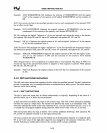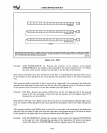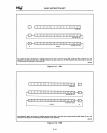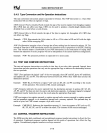
BASIC INSTRUCTION SET
3.6.1 Unconditional Transfer Instructions
JMP, CALL, RET,
INT
and IRET instructions transfer control from one code segment location to
another. These locations can be within the same code segment or in different code segments.
3.6.1.1 JUMP INSTRUCTION
JMP
(Jump) unconditionally transfers control
to
the target location.
JMP
is
a one-way transfer of
execution; it does not save a return address
on
the stack.
The
JMP
instruction always performs the same basic function of transferring control from the current
location
to
a
new
location. Its implementation varies depending
on
the following factors:
Is the address specified directly within the instruction or indirectly through a register or memory?
Is the target location inside or outside the current code segment selected
in
CS?
A direct
JMP
instruction includes the destination address as part of the instruction. An indirect
JMP
instruction obtains the destination address indirectly through a register or a pointer variable.
Control transfers through a gate or
to
a task state segment are available only in Protected Mode opera-
tion of the 80286. The formats of the instructions that transfer control through a call gate, a task gate,
or to a task state segment are the same. The label included in the instruction selects one
of
these three
paths to a
new
code segment.
Direct
JMP
within the current code segment. A direct
JMP
that transfers control
to
a target location
within the current code segment uses a relative displacement value contained in the instruction. This
can be either a 16-bit value or an 8-bit value sign extended
to
16
bits. The processor forms an effective
address
by
adding this relative displacement
to
the address contained in IP. IP refers to the next
instruction when the additions are performed.
Example:
JMP
NEAlLNEWCODE.
Transfers control
to
the target location labeled
NEAlL
NEWCODE, which
is
within the code segment currently selected
in
CS.
Indirect
JMP
within the current code segment. Indirect JMP instructions that transfer control to a
location within the current code segment specify an absolute address
in
one of several
ways.
First, the
program can
JMP
to
a location specified by a 16-bit register (any of AX, DX, CX,
BX,
BP,
SI, or DI).
The processor
moves
this 16-bit value into IP and resumes execution.
Example: JMP
SI. Transfers control
to
the target address formed
by
adding the 16-bit value contained
in
SI to the base address contained
in
CS.
The processor can also obtain the destination address within a current segment from a memory word
operand specified in the instruction.
Example:
JMP
PTlLX.
Transfers control to the target address formed
by
adding the l6-bit value
contained in the memory word labeled
PTR
X
to
the base address contained
in
CS.
A register can modify the address of the memory word pointer
to
select a destination address.
Example:
JMP
CASE_TABLE [BX]. CASE_TABLE
is
the first word
in
an array of
word
pointers.
The value of BX determines which pointer the program selects from the array. The
JMP
instruction then transfers control
to
the location specified by the selected pointer.
3-17


















